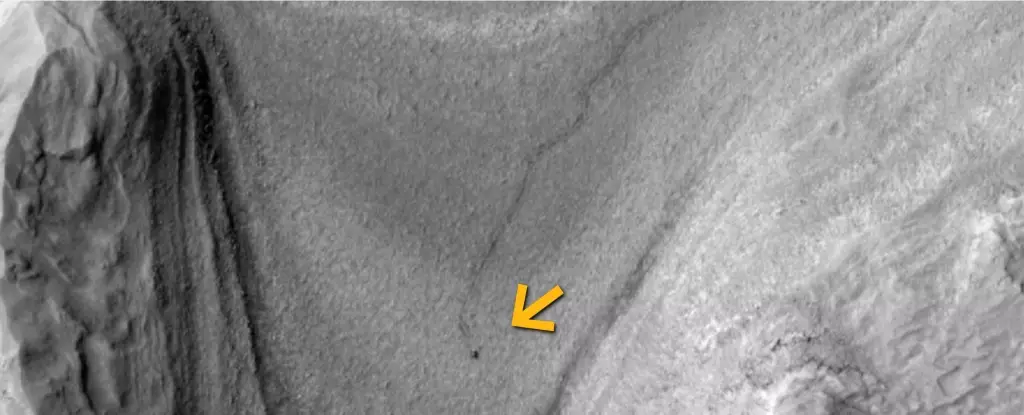Since its arrival on the Martian landscape in August 2012, NASA’s Curiosity rover has become a symbol of humanity’s quest for understanding beyond our earthly confines. Operating within the Gale Crater, Curiosity unravels the geological history and the past presence of water on the red planet. This mission is not merely a journey of science; it’s an assertion of human curiosity and a relentless pursuit of knowledge about an alien world. Adorned with advanced scientific instruments, the rover transcends its robotic form, acting as a steward of exploration in an environment that is both captivating and harsh.
A Glimpse from Above
A recent image captured by the Mars Reconnaissance Orbiter elevates the narrative of Curiosity from mere robotic existence to a poignant tale of solitude and purpose. The photograph immortalizes Curiosity as a mere dot against the expansive Martian surface, emphasizing not only its isolation but also the enormity of the challenges it confronts. Observers are reminded that this lonely machine is thrust into an environment where it has no companions and supports no one but itself in its meticulous endeavor to unveil the mysteries of Mars. The orbiter’s ability to photograph the rover in motion—a small black speck leaving a trail in the dusty terrain—marvelously conveys the journey undertaken by Curiosity, covering around 320 meters over a series of eleven painstaking drives.
Understanding the Mechanics of Exploration
Curiosity’s slow-paced navigation—limited to 160 meters per hour—might seem frustratingly tedious. However, this reticence is not without reason. The rover’s deliberate movements minimize power consumption from its 110-watt nuclear generator and mitigate the risks associated with navigating the treacherous surfaces of Mars. Weighing significantly heavier than an average human, Curiosity requires exceptional caution to avoid potential pitfalls that could jeopardize its mission. Thus, its slow pace transforms into a calculated strategy rather than an impediment, allowing it to safely navigate the unknown terrain that unfolds before it.
Encounters with Geological History
In February, while traversing the Gediz Vallis channel, Curiosity came across what may be remnants of an ancient watery past. Within this channel, the rover uncovered pure sulfur—an exciting find that offers clues to the planet’s aqueous history. Each geological feature Curiosity encounters offers tantalizing signs of the processes that have shaped the Martian landscape, urging scientists to dig deeper into the planetary narrative. Recent explorations have taken Curiosity across formation after formation; from the aptly named Devil’s Gate to the cake-like layers of Hale Telescope, each locale provides a rich tapestry of Martian geology, waiting to reveal its secrets to the ever-curious rover.
The Promise of Boxwork Relief Patterns
As Curiosity beckons toward the unique boxwork formations at the base of Mount Sharp, it enters territory steeped in promise. Here, the elegant patterns forged by mineral deposits could signify not just the geological story of Mars but also hint at its long-held potential for ancient life. On Earth, similar formations emerge when groundwater carves through the rock, depositing minerals in fractures. The parallels suggest that Mars may once have house microbial life in a warmer and wetter environment than the one it now endures.
The drive to explore the boxwork formations is laden with hope. Should Curiosity indeed locate vital minerals and trace evidence of life, it would transform our understanding of the Martian planet. This prospect underlines a sentiment resonating among scientists—the notion that life may not be unique to Earth but could exist or have existed in varied forms throughout the cosmos.
A Testament to Human Ingenuity
The saga of Curiosity symbolizes not just robotic exploration, but a manifestation of human resilience and determination in the face of the unknown. Each data transmission and image relayed back to Earth reflects a profound commitment to understanding the cosmos. The rover’s existence on Mars is a reminder that even in the solitude of space, we as a species are reaching out, striving to connect with the universe surrounding us. Curiosity is a testament to what we can achieve when we dare to wander beyond our comfort zone, igniting the flames of exploration and wonder that drive human innovation.

